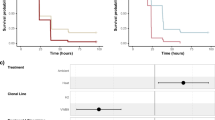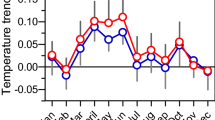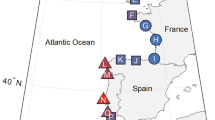Abstract
DURING the autumn vacation, we made geomorphological and biological surveys in the Red Sea hills and coastal plain north of Port Sudan. Details of these will be published later. While trekking among uncharted jebels in the area 36.50° E., 21.00° N., high surface temperatures were recorded, especially on wind-blown sand. For example, on September 24, 1960, at 1300h. local time, when the air temperature varied between 40.5 and 43.5° C. (105–110° F.) the surface sand temperature was 83.5° C. (182.5° F.)as measured with an electrical resistance thermometer employing thermistors1. The only animal to be seen was a solitary grasshopper. Four hours later, when the temperature had fallen to 32.0° C. (90.0° F.), the sand temperature had dropped 45.5° C. to 38.0° C. (100.5° F.) and some ants were crawling over it.
This is a preview of subscription content, access via your institution
Access options
Subscribe to this journal
Receive 51 print issues and online access
$199.00 per year
only $3.90 per issue
Buy this article
- Purchase on SpringerLink
- Instant access to full article PDF
Prices may be subject to local taxes which are calculated during checkout
Similar content being viewed by others
References
Cloudsley-Thompson, J. L., Ann. Mag. Nat. Hist., (12), 9, 305 (1956).
Buxton, P. A., “Animal Life in Deserts” (Arnold, London, 1923).
Williams, C. B., in “Biology of Deserts”, edit. by Cloudsley-Thompson, J. L. (Inst. Biol., London, 1954).
Author information
Authors and Affiliations
Rights and permissions
About this article
Cite this article
BERRY, L., CLOUDSLEY-THOMPSON, J. Autumn Temperatures in the Red Sea Hills. Nature 188, 843 (1960). https://doi.org/10.1038/188843a0
Issue date:
DOI: https://doi.org/10.1038/188843a0



